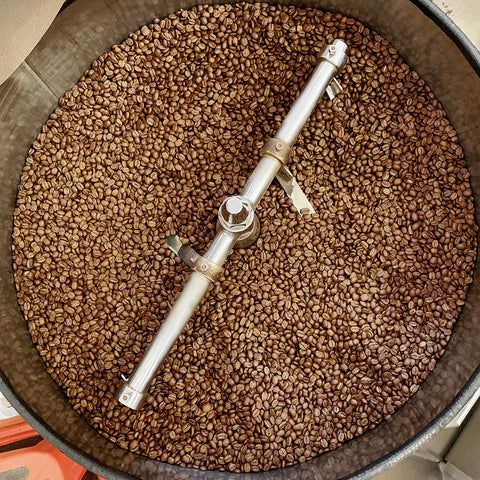Roasting is the process that makes your kaapi deliciously strong, aromatic, and crisp.
Did you know that the process has been around for centuries? The Arabs in the 15th century are credited for being the first to roast green coffee beans.
We think it is important for all of you to know what coffee roasting is like as that would help you understand what a difference it can make to the taste of your kaapi.
Roasting Coffee Beans
Roasting coffee requires a great deal of attention, skill, and foresight. You can’t expect to use the same steps for all coffee varieties and hope to get the desired output.
The first step in roasting coffee is reducing the moisture content within the beans. With the heat beginning to work on the beans, they turn from green to a pale yellow colour.
A term known as the “first crack” is very important to coffee roasting. It occurs when there’s steam build-up within the bean, which causes greater pressure on the inside and results in a crack.
The timeline at which it occurs also determines some aspects of the coffee’s flavour profile.

After the 7-8 minute mark, the beans move towards a medium roast. That’s when the sugars in the bean caramelise further, and the beans expand in size.
At the end of the roasting process, the beans are placed in large vats and cooled.
Once the beans are done roasting, they emit natural gases.
Then, they are sorted through to ensure only the good quality and properly roasted beans are selected for packaging. Any beans that get excessively roasted are removed from the mix.
When coffee beans are done roasting, they weigh significantly lesser than green beans and have a different texture.
Types of Coffee Roasts & What They Taste Like
Light, medium, and dark roasts are the 3 most common roast levels, with each being roasted for a different duration at different temperatures.
Light roasts are when the green beans turn a mild brown colour. The coffees brewed with light-roasted beans have a high acidity and a fruity flavour profile.
Once the bean reaches the medium roast level is when a subtle shine becomes visible on the bean’s surface. This is a sign of the oils beginning to emerge.

Medium-roast coffees have a far more balanced feel and taste as compared to light roasts. They tend to be sweet with only moderate acidity.
Those who like their coffees to be dark, bitter, and smoky should opt for dark roasts. These have been typically roasted for well over 15 minutes.
They have quite an oily surface and minimal acidity. Dark roast beans tend to be dark brown to black in colour.
Indian filter kaapis are roasted at a medium to dark level to bring out that bold flavour.
This is just a brief guide about coffee roasting. We hope it was insightful for you!
If you want to know more about how we roast our Malgudi Days kaapis, subscribe to our newsletter and stay tuned! We’re going to be sharing our roasting philosophy and approach to bringing you the best Indian specialty coffees.
Leave a comment: